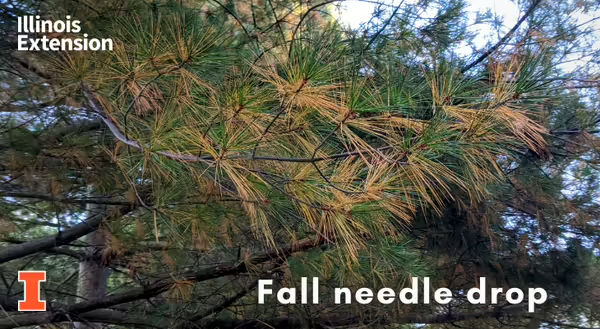
The arrival of fall/autumn brings not only cooler temperatures but also a change in scenery. Our trees transition from green to golds, yellows, oranges, purples, reds, and browns, blanketing our landscapes in a kaleidoscope of colors. We expect our deciduous trees like maples, oaks, sweetgum, and dogwoods to change color and drop their leaves. They aren’t the only trees that do undergo these changes, though.
Despite being called evergreens, conifers (pine, spruce, yew, cedar, etc.) will also drop their needles (leaves) in the fall. Just like in deciduous trees, the leaves of conifers will change colors and begin to drop in response to shorter days and cooler temperatures as winter approaches. While this may be alarming, this is normal for this time of year.
Conifers will produce new needles every year. Therefore, there are always new and old needles on a tree at one time. How long these older needles stay on a tree will depend on the species. Eastern white pines will usually keep their needles for 2-3 years. Other pines, like Austrian and Scots, pines usually keep their needles for three years, and red pines for four years. Spruces typically keep their needles longer than pines do, generally for 5-7 years.
Only the oldest needles are dropped during fall (aka natural, seasonal, and inner) needle drop. Since new needles are added every year, these older needles are on the inside of the tree canopy. Just like in deciduous trees, the older needles will begin to turn colors, like yellow, brown, or reddish-tan, when it is their turn to be dropped from the tree.
Fall needle drop occurs uniformly throughout the tree from top to bottom. If entire branches or needles at the tips of branches begin to die or the pattern is not uniform in the tree, it is not fall needle drop. Something else is happening to the tree and will warrant a closer inspection.
Fall needle drop is probably most noticeable in Eastern white pine. Since these trees only hold their needles for 2-3 years, there is less new growth at the tips to cover up the older, yellowing foliage. Additionally, these trees have a relatively open structure, making it easy to see fall needle drop.
There are some conifers, such as larch and bald cypress, that aren’t evergreen, but are deciduous and will lose all their needles each fall. While this may be alarming, especially if you’re not familiar with these trees, it’s natural for these species. Just like their deciduous broadleaf brethren, they will produce new foliage in the spring.
Good Growing Tip of the Week: Conifers and other evergreens haven’t discovered a fountain of youth that allows their needles/leaves to live forever. Eventually, they will drop from the plant. What makes them evergreen is that their leaves persist for more than one year before falling.
Want to get notified when new Good Growing posts are available? SIGN UP HERE!